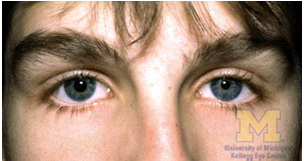Question: A patient presents with anisocoria. Examination of the pupils reveals that the right pupil reacted briskly to light, whereas the larger left pupil was very sluggishly reactive.
Which of the following possibilities should be considered?
- Adie’s pupil
- 3rd nerve palsy
- Chemical blockade
- Iris sphincter damage
 1
1
____________________________________________________________
Correct Answers: all are correct.
Explanation1:
“Anisocoria, or a difference in the diameter of the pupils in dim illumination, may be physiologic if the difference is less than 1 mm and both pupils react briskly and equally to light. Otherwise it may be pathologic.
There are four possible causes:
➧Parasympathetic innervation failure causes a relatively dilated pupil that reacts sluggishly to direct light.
The major concern, as with ptosis, is a third cranial nerve palsy, especially one caused by an aneurysm. However, anisocoria is never caused by a third nerve palsy unless there are other signs of a third cranial nerve palsy—ptosis, reduced ocular movements, or ocular misalignment.
A common cause of isolated anisocoria is a viral infection of the ciliary ganglion (Adie’s syndrome), an orbital structure that receives the parasympathetic component of the third cranial nerve.
➧Horner’s syndrome causes anisocoria in which the affected pupil is smaller, but both pupils react briskly to light. Ptosis is usually present but is always mild (2 mm or less).
For more information on Horner’s syndrome see Ptosis in this section.
➧Chemical blockade. If parasympatholytic (atropine-like) chemicals come in contact with the conjunctiva by accidental (or deliberate!) instillation, they will deactivate the iris sphincter muscle and cause (often very wide) pupil dilation.
This occurs most commonly among hospital personnel and those exposed to atropine-containing plants.
➧Iris sphincter damage. Inflammation and trauma to the iris sphincter are other causes of anisocoria. The pupil is usually irregular in shape and magnified examination shows evidence of muscle damage.”
What to do (when a pupil is sluggishly reactive to light)?
If you suspect third cranial nerve palsy, refer immediately for brain imaging. Other suspected diagnoses can wait, but anisocoria must always be evaluated unless you are convinced it is physiologic.”
Reference:
More than 600 additional neuro-ophthalmology questions are freely available at http://EyeQuiz.com.
Questions prior to September 2016 are archived at http://ophthalmology.stanford.edu/blog/
After that, questions are archived at https://neuro-ophthalmology.stanford.edu
Follow https://twitter.com/NeuroOphthQandA to be notified of new neuro-ophthalmology questions of the week.
Please send feedback, questions and corrections to tcooper@stanford.edu.